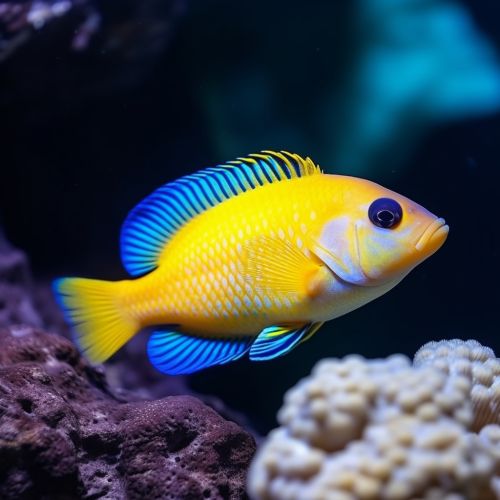Neolamprologus pulcher
Taxonomy and Naming
The Neolamprologus pulcher, also known as the Daffodil Cichlid, is a species of cichlid endemic to Lake Tanganyika in East Africa. The genus Neolamprologus is part of the larger family Cichlidae, which includes many other popular aquarium species. The specific epithet pulcher is derived from Latin, meaning "beautiful".


Description
Neolamprologus pulcher is a small to medium-sized cichlid, typically reaching lengths of 4 to 5 inches (10 to 12 cm). The body is elongated and slightly compressed laterally. The coloration is predominantly yellowish with blue hues, particularly on the dorsal and caudal fins. The intensity of the coloration can vary depending on the fish's mood and health status. The eyes are typically bright blue, adding to the overall appeal of this species.
Distribution and Habitat
This species is endemic to Lake Tanganyika, one of the African Great Lakes, where it is found along the rocky shorelines. The lake's unique chemistry, with high pH and hardness levels, contributes to the species' specific habitat requirements. Neolamprologus pulcher prefers areas with plenty of rocks and crevices, which it uses for shelter and breeding.
Behavior
Neolamprologus pulcher is known for its complex social structure, often referred to as a cooperative breeding system. This system involves a dominant breeding pair and several subordinate individuals that assist in raising the offspring. This behavior is relatively rare among fish and has been the subject of extensive scientific study.
Diet
In the wild, Neolamprologus pulcher feeds primarily on small invertebrates and algae. In captivity, they readily accept a variety of foods, including flake food, pellets, and live or frozen foods such as brine shrimp or bloodworms.
Reproduction
The breeding behavior of Neolamprologus pulcher is closely tied to its social structure. The dominant pair will lay eggs in a sheltered area, often a crevice between rocks. The subordinate individuals then assist in guarding the eggs and fry from predators.
In the Aquarium
Neolamprologus pulcher is a popular choice among aquarium hobbyists due to its vibrant coloration and interesting behavior. However, it requires specific water conditions that mimic its natural habitat in Lake Tanganyika. This includes high pH and hardness levels, as well as a temperature range of 24 to 27 degrees Celsius (75 to 81 degrees Fahrenheit).
Conservation Status
The conservation status of Neolamprologus pulcher is currently not evaluated by the International Union for Conservation of Nature (IUCN). However, like many species in Lake Tanganyika, it may be threatened by overfishing and habitat degradation.
